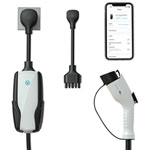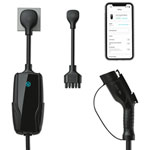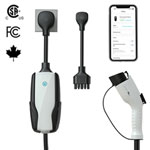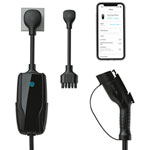EV Chargers & Accessories
EV chargers and driving change
Our Holiday Price Guarantees
Shop deals early knowing that the price of any product with a "Boxing Day Price Now" or "Lowest Price of Dec." badge won't go any lower. If it does, we'll refund the difference. Guaranteed.
Charge your electric vehicle at home with EV chargers
If you have entered the world of sustainable electric vehicles, you might be looking for an EV charger to keep it powered up for all your adventures.
EV chargers and types
Electric vehicles (EVs) are on the rise and represent the sustainable future of driving. Rather than use unleaded gasoline, these vehicles run on electricity. The number of EV chargers popping up throughout cities, including on streets corners, in shopping centre and store parking lots, gas stations, and other spots, is growing. But it’s also important to have an EV charger at home.
Home charging stations are the future of refueling. Most commonly, you’ll want a Level 2 charging station. These have similar voltage to a dryer or oven (240V, 30 amps), and let you charge while the vehicle is parked in the driveway. Since peak pricing on electricity is usually during the day, the nighttime is the perfect time to recharge the car so you wake up to a full battery. You can usually fully charge an electric vehicle with a Level 2 charger in 6-14 hours, 4-8 hours for a hybrid.
There are also Level 1 chargers, or portable chargers, which are basic charging cords you can plug into any standard 120V household outlet. However, this charges at a much slower rate, giving you about an 8km range after an hour (12-20 hours to fully charge a standard electric car, 6-12 for hybrid vehicles). But this is a good solution in a pinch if you need to be able to continue to get home or go for a short drive.
The third option is Level 3 chargers, also known as fast chargers. These use a direct current connection to an electrical system and can charge an electric vehicle in 1-4 hours, or as quick as 15 minutes for a plug-in hybrid. These are more commonly found in commercial spaces and are open for use to any electric vehicle owner. They are useful when you are already on the road: you can stop for a coffee while your car recharges. But it’s worthwhile to have an option to charge at home, and to keep a portable charger in the trunk for emergencies.
What to consider when choosing an EV charger
When choosing an EV charger for your home, it should be simple to install both indoors and out, have Energy Star certification for high efficiency, and be compatible with your particular electric vehicle (some have a universal connector for any North American car).
Many have adjustable power capacity so you can connect it to a lower power circuit for those times when you aren’t in a rush and can wait longer for the vehicle to be fully charged. It should also have a watertight enclosure if it’s going to be placed outside so that it can withstand the elements. This includes a cable that won’t freeze or crack during the harsh Canadian winters.
To decide which one is right for you, evaluate your personal driving habits. How often do you think you’ll need to charge the car based on how frequently and how far you drive? When will you most likely be able to charge it? And how quickly will you need it, in most cases? If you drive a lot, or far distances, you will want to consider a Level 2 charger that can have you up and running quicker.
The latest EV chargers add useful high-tech features, including app connectivity so you can schedule charging, set reminders, and check the charging status remotely from your phone. Some can even work with Amazon Alexa for voice control. Some also offer a padlock for safety, wall mount bracket, and extended warranty, all of which are worth considering.
How to install and maintain an EV charger
Once you have chosen an EV charger, you should hire a certified electrician to handle the installation. They will walk you through the process, help you find the perfect spot, and ensure that everything is done safely and that you have sufficient electrical service to accommodate it. You’ll also need space on the electrical panel for a circuit breaker for the EV charger, or the electrician may have to add one.
EV chargers are usually set up on the driveway, in the garage, or wherever you can get the car close enough to the power source. If you have a detached garage that’s far from a power source, you might need to connect the garage to your electrical panel by running wires underground or to drill holes to run wiring from a ceiling if the electrical panel is in a basement. An electrician can help with all this.
To maintain an EV charger, make sure the charging cables are always securely stored when not in use. Check all the parts from time to time to ensure they are in working order. Generally, keep the unit clean, wiping it down periodically and removing dust or debris. To avoid degrading the battery more quickly and wasting phantom power, consider unplugging the EV charger when it isn’t being used. Check if there’s a general maintenance or inspection schedule noted in the instruction manual and follow this. With proper care, an EV charger can last for up to 10 years.







